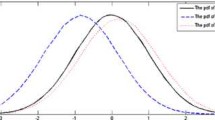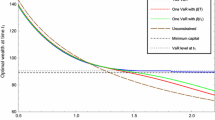Abstract
We study risk sharing problems with quantile-based risk measures and heterogeneous beliefs, motivated by the use of internal models in finance and insurance. Explicit forms of Pareto-optimal allocations and competitive equilibria are obtained by solving various optimization problems. For Expected Shortfall (ES) agents, Pareto-optimal allocations are shown to be equivalent to equilibrium allocations, and the equilibrium pricing measure is unique. For Value-at-Risk (VaR) agents or mixed VaR and ES agents, a competitive equilibrium does not exist. Our results generalize existing ones on risk sharing problems with risk measures and belief homogeneity, and draw an interesting connection to early work on optimization properties of ES and VaR.
Similar content being viewed by others
Notes
Following the tradition in the literature of risk sharing, we refer to a participant in the risk sharing problem, such as an investor or a firm, as an agent.
In this paper, all random future positions are already discounted, and that is why expectations correspond to prices.
Roughly speaking, the first FTWE states that, under some conditions, an equilibrium allocation is Pareto-optimal, and the second FTWE states that, under some conditions, a Pareto-optimal allocation is an equilibrium allocation.
Following the risk management literature, a functional \(f:\mathcal {X}\rightarrow \mathbb {R}\) is called translation invariant if \(f(X+c)=f(X)+c\) for all \(X\in \mathcal {X}\) and \(c\in \mathbb {R}\).
This remark is based on a very valuable suggestion of an anonymous referee.
References
Acciaio, B., Svindland, G.: Optimal risk sharing with different reference probabilities. Insur. Math. Econ. 44(3), 426–433 (2009)
Anthropelos, M., Kardaras, C.: Equilibrium in risk-sharing games. Finance Stoch. 21(3), 815–865 (2017)
Artzner, P., Delbaen, F., Eber, J.-M., Heath, D.: Coherent measures of risk. Math. Finance 9(3), 203–228 (1999)
BCBS Standards: Minimum capital requirements for Market Risk. January 2016. Basel Committee on Banking Supervision. Bank for International Settlements, Basel (2016)
Barrieu, P., El Karoui, N.: Inf-convolution of risk measures and optimal risk transfer. Finance Stoch. 9(2), 269–298 (2005)
Chen, H., Joslin, S., Tran, N.-K.: Rare disasters and risk sharing with heterogeneous beliefs. Rev. Financ. Stud. 25(7), 2189–2224 (2012)
Dana, R.-A., Le Van, C.: Overlapping sets of priors and the existence of efficient allocations and equilibria for risk measures. Math. Finance 20(3), 327–339 (2010)
Embrechts, P.: A Darwinian view on internal models. J. Risk 20(1), 1–21 (2017)
Embrechts, P., Liu, H., Wang, R.: Quantile-based risk sharing. Oper. Res. (2017). https://papers.ssrn.com/sol3/papers.cfm?abstract_id=2744142(forthcoming)
Embrechts, P., Wang, R.: Seven proofs for the subadditivity of expected shortfall. Depend. Modeling 3, 126–140 (2015)
Föllmer, H., Schied, A.: Stochastic Finance. An Introduction in Discrete Time, 4th edn. Walter de Gruyter, Berlin (2016)
Jouini, E., Schachermayer, W., Touzi, N.: Optimal risk sharing for law invariant monetary utility functions. Math. Finance 18(2), 269–292 (2008)
McNeil, A.J., Frey, R., Embrechts, P.: Quantitative Risk Management: Concepts, Techniques and Tools, Revised edn. Princeton University Press, Princeton (2015)
Pflug, G.C.: Some remarks on the value-at-risk and the conditional value-at-risk. In: Uryasev, S. (ed.) Probabilistic Constrained Optimization, pp. 272–281. Springer, Dordrecht (2000)
Pflug, G.C.: Subdifferential representations of risk measures. Math. Program. Ser. B 108(2–3), 339–354 (2006)
Pflug, G.C., Pichler, A.: Multistage Stochastic Optimization. Springer, Berlin (2014)
Pflug, G.C., Pichler, A., Wozabal, D.: The \(1/n\) investment strategy is optimal under high model ambiguity. J. Bank. Finance 36(2), 410–417 (2012)
Pflug, G.C., Pohl, M.: A review on ambiguity in stochastic portfolio optimization. Set-Valued Var. Anal. (2017). https://doi.org/10.1007/s11228-017-0458-z
Pflug, G.C., Römisch, W.: Modeling, Measuring and Managing Risk. World Scientific, Singapore (2007)
Pflug, G.C., Wozabal, D.: Ambiguity in portfolio selection. Quant. Finance 7(4), 435–442 (2007)
Puccetti, G., Wang, R.: Extremal dependence concepts. Stat. Sci. 30(4), 485–517 (2015)
Rockafellar, R.T., Uryasev, S.: Optimization of conditional value-at-risk. J. Risk 2, 21–42 (2000)
Rockafellar, R.T., Uryasev, S.: Conditional value-at-risk for general loss distributions. J. Bank. Finance 26(7), 1443–1471 (2002)
Rüschendorf, L.: Mathematical Risk Analysis Dependence, Risk Bounds, Optimal Allocations and Portfolios. Springer, Heidelberg (2013)
Starr, R.M.: General Equilibrium Theory: An Introduction, 2nd edn. Cambridge University Press, Cambridge (2011)
Xiong, W.: Bubbles, crises, and heterogeneous beliefs. In: Fouque, J.-P., Langsam, J. (eds.) Handbook for Systemic Risk, pp. 663–713. Cambridge University Press, Cambridge (2013)
Author information
Authors and Affiliations
Corresponding author
Additional information
The authors thank the two anonymous referees, the Guest Editor, and the Editor for valuable comments that improved the content and the presentation of the paper. P. Embrechts would like to thank the Swiss Finance Institute for financial support. Part of this paper was written while he was Hung Hing Ying Distinguished Visiting Professor at the Department of Statistics and Actuarial Science of the University of Hong Kong. H. Liu thanks the University of Science and Technology of China for supporting her visit in Fall 2017. T. Mao was supported by the NNSF of China (Nos. 71671176, 11371340). R. Wang acknowledges support from the Natural Sciences and Engineering Research Council of Canada (RGPIN-435844-2013).
Rights and permissions
About this article
Cite this article
Embrechts, P., Liu, H., Mao, T. et al. Quantile-based risk sharing with heterogeneous beliefs. Math. Program. 181, 319–347 (2020). https://doi.org/10.1007/s10107-018-1313-1
Received:
Accepted:
Published:
Issue Date:
DOI: https://doi.org/10.1007/s10107-018-1313-1




